There’s probably no broader angle to consider your business than the customer experience. It encompasses every single interaction a customer has with your brand, products, services, support, and even social media.
It’s crucial you make it memorable—in a good way.
Our guide will quickly walk you through:
✳️ What customer experience is, and why it should never go off your radar
✳️ How to build a customer experience strategy that works
✳️ The best customer experience metrics
✳️ Practical tips on how to optimize your CX quickly
✳️ The best customer experience tools
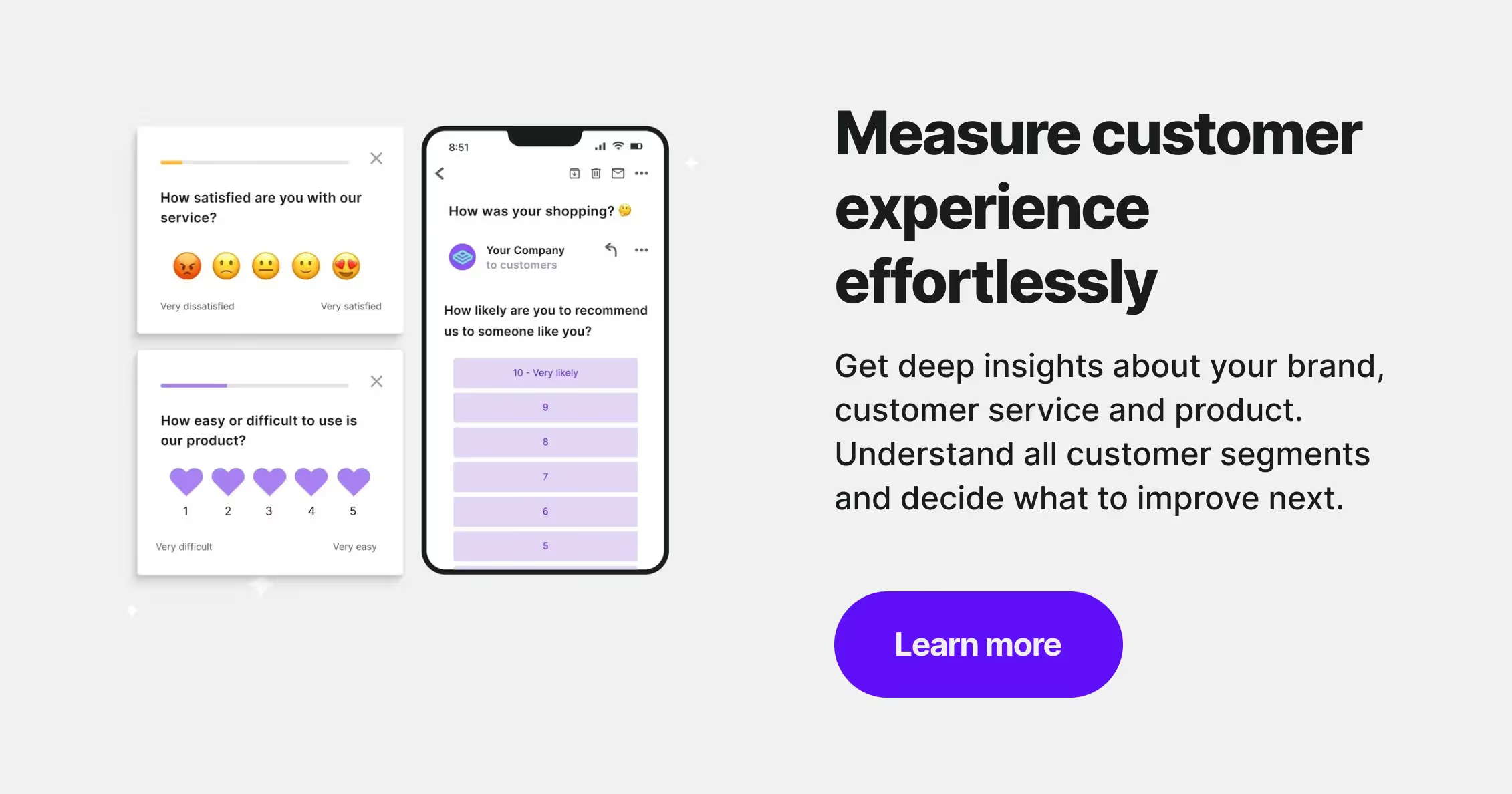
What is customer experience?
Customer experience (CX) refers to how your customers view and feel about interacting with a brand or company throughout the customer journey.
It includes every touchpoint, from the initial awareness stage to post-purchase support and loyalty. CX is the result of all customer interactions with your company's products, services, employees, and digital interfaces.
Why is customer experience important?
Customer experience is a critical aspect of any business strategy. Let’s have a look at the five key reasons why:
🤝Improve customer satisfaction and loyalty
The better customer experience you provide, the more satisfied your customers will be. When they feel valued, and their needs are met, they are more likely to remain loyal to your brand and recommend it to others.
It’s a straight road to building customer loyalty based on trust in your brand, with the bonus of long-term customer retention and advocacy.
🤝 Improve customer retention
Bringing in new customers costs a lot of money, so retaining existing ones is crucial for long-term success. By ensuring your clientele gets the best experience with your product, you actively reduce customer churn and improve retention rates.
🤝 Increase revenue and profitability
86% of customers are willing to pay more for a good CX. Moreover, satisfied customers are more likely to make repeat purchases, upgrade their services, and spend more with a company over time.
🤝Competitive advantage
Exceptional customer experience can be a key differentiator in your industry. The market’s crowded out there, and with so many good products it’s the other factors that can make or break a deal.
🤝 Improve brand reputation
Enhanced brand reputation and positive word-of-mouth marketing are yet additional outcomes of positive customer experience.
When customers have great experiences with your company and product, they are more likely to share it with others online—for example, through online reviews or ratings—and offline.
🤝Make decisions based on data
You can and should measure your efforts around customer experience. By analyzing customer satisfaction and related CX metrics, you can continuously identify trends, prioritize improvements, and allocate resources effectively to better address customer needs and preferences.
💡 Read more: 6 Great Customer Experience Goals To Set and Aim for
What is the difference between customer experience, customer service, and user experience?
When discussing customer experience, it's essential to understand how it differs from related concepts like customer service and user experience (UX). While these terms are often used interchangeably, they have distinct meanings and implications for businesses.
🌐 Customer Experience (CX)
Customer experience encompasses the entire customer journey with your company, from the first interaction to post-purchase support and beyond.
As such, CX focuses on the overall perception and emotions a customer has when engaging with your brand and involves multiple departments within the organization.
🛟 Customer Service
Customer service is a specific aspect of the overall customer experience. It refers to the assistance and support you provide to customers before, during, and after a purchase.
While customer service is a crucial component of CX, it is only one part of the larger picture.
🎠 User Experience (UX)
User experience primarily focuses on how easy, efficient, and enjoyable it is for users to interact with your product, particularly websites and mobile apps.
While UX is an important aspect of CX, it is more narrowly focused on the usability and functionality of specific touchpoints.
What is a customer experience strategy, and how to develop one?
A customer experience strategy is a set of guidelines for how you interact with customers across the company. It helps create positive experiences that keep customers happy and coming back.
When developing one, you should focus on the big picture and ensure it’s cross-functional across different company teams and departments. Most importantly, prioritize what matters most to your customers.
Let’s see how to start ⤵️
Build a customer-centric culture
You read it right. To create a truly exceptional customer experience, your entire company has to look in the same direction, or in other words, eat your own dog food. 🍗
Here are some tips on how to achieve it:
- Lead by example—get your C-levels on board. They should be the primary ambassadors, demonstrating how great customer experience helps your company reach business goals.
- Support your customer-facing teams with training and mentorship programs. Teach your staff what it means to put the customer first and provide regular feedback.
- Become customer-obsessed. Take the example of Preply—one of its North Star metrics is NPS, a core CX metric. Centering their business and product decisions around customer needs aligns teams toward the same goal of providing a great language learning experience.
- Make the voice-of-customer feedback programs a company thing. One example could be sharing feedback with the whole organization by connecting your surveys to Slack. Bring your customer feedback to life, turning it into more than just another row in a spreadsheet.
Develop a vision
Your vision sets the direction for your customer experience efforts. Think about how you want customers to feel when they interact with your company. Do you want to be known for friendly service? Fast problem-solving?
Write down your vision in simple terms. For example: "We want customers to feel valued and heard." This gives your team a clear goal to work towards.
Get others on board with your vision by sharing it widely across the company.
Map the journey
Customer journey mapping will help you understand how customers interact with your brand. By taking a good look at every step a customer takes when interacting with your business, you’ll be able to spot areas that need improvement.
So, how do you start?
First, list all customer touchpoints—the places where customers interact with you throughout the journey along the funnel. It could be on the website, inside your product or—in the case of physical goods—through in-store visits.
Customer touchpoints include:
👉Seeing an ad
👉Visiting your website
👉Talking to customer service
👉Making a purchase
For each touchpoint, ask the following questions:
👉What is the customer trying to do?
👉How are they feeling?
👉What problems might they face?
👉How can we make this step better?
By mapping your business, you can view it from the customer's perspective. This allows you to spot gaps in service or areas where customers might get confused.
Use this info to create a visual map that outlines the customer's path, from the awareness stage to the advocacy stage. Remember, a good journey map shows more than just a list of touchpoints—it also captures customer emotions and thoughts at each stage.
Train your team
When employees like their jobs, it shows in how they treat customers. Companies with engaged employees grow faster. They often see their revenue increase 1.8 times quicker than others.
Effective training builds confidence and skills, helping employees handle customer needs better.
Here are some key training areas:
Key training areas:
📚 Product knowledge
📚 Problem-solving
📚 Communication skills
📚 Empathy and active listening
Make training part of your culture. Don't just do it once—offer regular refresher courses and updates.
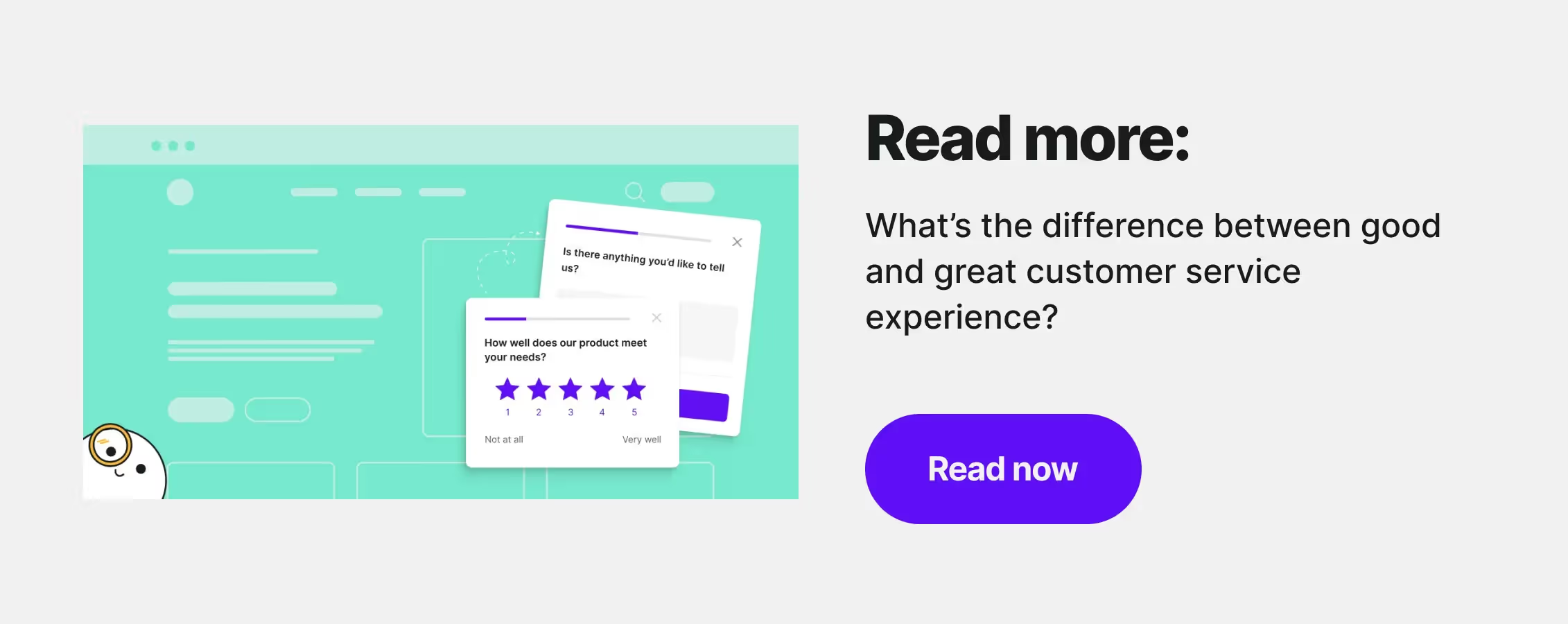
Set objectives
Turn your vision into specific, measurable goals, such as:
- Reduce customer wait times by 30%
- Improve satisfaction scores by 15%
- Increase repeat purchases by 20%
Set a mix of short-term and long-term goals. This helps you make progress while keeping an eye on the big picture.
💡 Read more: 10 Best Customer Experience Metrics to Measure for Customer Success
Why customer feedback should be a part of your customer experience strategy?
To make your customer experience strategy relevant, you need to nourish it with relevant insights from customer feedback.
Apart from telling you what your customers like and dislike about your business, regular feedback helps you track and analyze changes in customer sentiment over time. This guides your long-term customer experience strategy.
How to measure customer experience?
Perhaps the best part about customer experience is that, although it revolves around quite volatile concepts such as “how customers feel about your brand,” it is completely measurable. It allows you to understand how well your company is meeting customer expectations and identify areas for improvement.
Here are six key metrics and methods to help you measure and analyze your CX:
Net Promoter Score (NPS)
Net Promoter Score is a loyalty metric that measures the likelihood of customers recommending your brand or product to others. The basic version asks customers a single question: "On a scale of 0-10, how likely are you to recommend our company to a friend or colleague?"
Try our free NPS survey template ⤵️
NPS helps you understand the overall loyalty and sentiment of your customer base. Based on their responses, customers are categorized as promoters, passives, or detractors.
Customer Satisfaction Score (CSAT)
Customer Satisfaction Score is a metric that measures how satisfied your customers are with a specific product, service, or interaction.
Try our free CSAT survey template ⤵️
Mostly used in a transactional way, CSAT gauges the immediate satisfaction level of your customers after a particular touchpoint or experience—making a purchase, interacting with customer support, or using a product.
Customer Effort Score (CES)
Customer Effort Score measures how much effort a customer has to exert to complete a specific task, such as resolving an issue or making a purchase.
Try our free CES survey template ⤵️
It identifies areas where you can streamline processes and reduce friction in the customer journey. CES is typically measured with surveys that ask customers to rate the ease of their experience on a scale from 1 to 5.
Customer Lifetime Value (CLV)
Customer Lifetime Value is a metric that represents the total amount customers are expected to spend on your products or services throughout their entire relationship with your company.

This metric pinpoints your most valuable customers, helping you make more accurate decisions about customer acquisition, retention, and resource allocation.
Customer Churn Rate
The churn rate measures the percentage of customers who stop doing business with your company over a specific period. It helps you understand how well you keep customers and identifies potential issues that may be causing them to leave.

By tracking the churn rate, you can take proactive steps to improve customer retention and minimize revenue loss.
Customer Retention Rate
Retention rate is the opposite of churn rate and measures the percentage of customers who continue doing business with your company over a specific period.

It helps you understand the effectiveness of your customer retention strategies and the overall health of your customer relationships.
How can you improve customer experience with Survicate? (4 more ways)
Collecting and analyzing customer feedback with online surveys is an effective way to obtain measurable data on your customer experience efforts, and—of course—you can do it with Survicate.
But there are more ways you can boost your CX workflows.
1. Connect Survicate with your CRM
Your CRM is your customer command center. That’s why connecting your voice of customer programs with your CRM data can be a game changer in terms of customer experience.
Take the Survicate-HubSpot integration, for example, and enjoy the convenience of automatically identifying survey respondents without needing to ask for their contact details. All survey data is synchronized with HubSpot with just one click, and survey responses can automatically trigger HubSpot workflows. This and more, seamlessly integrated.
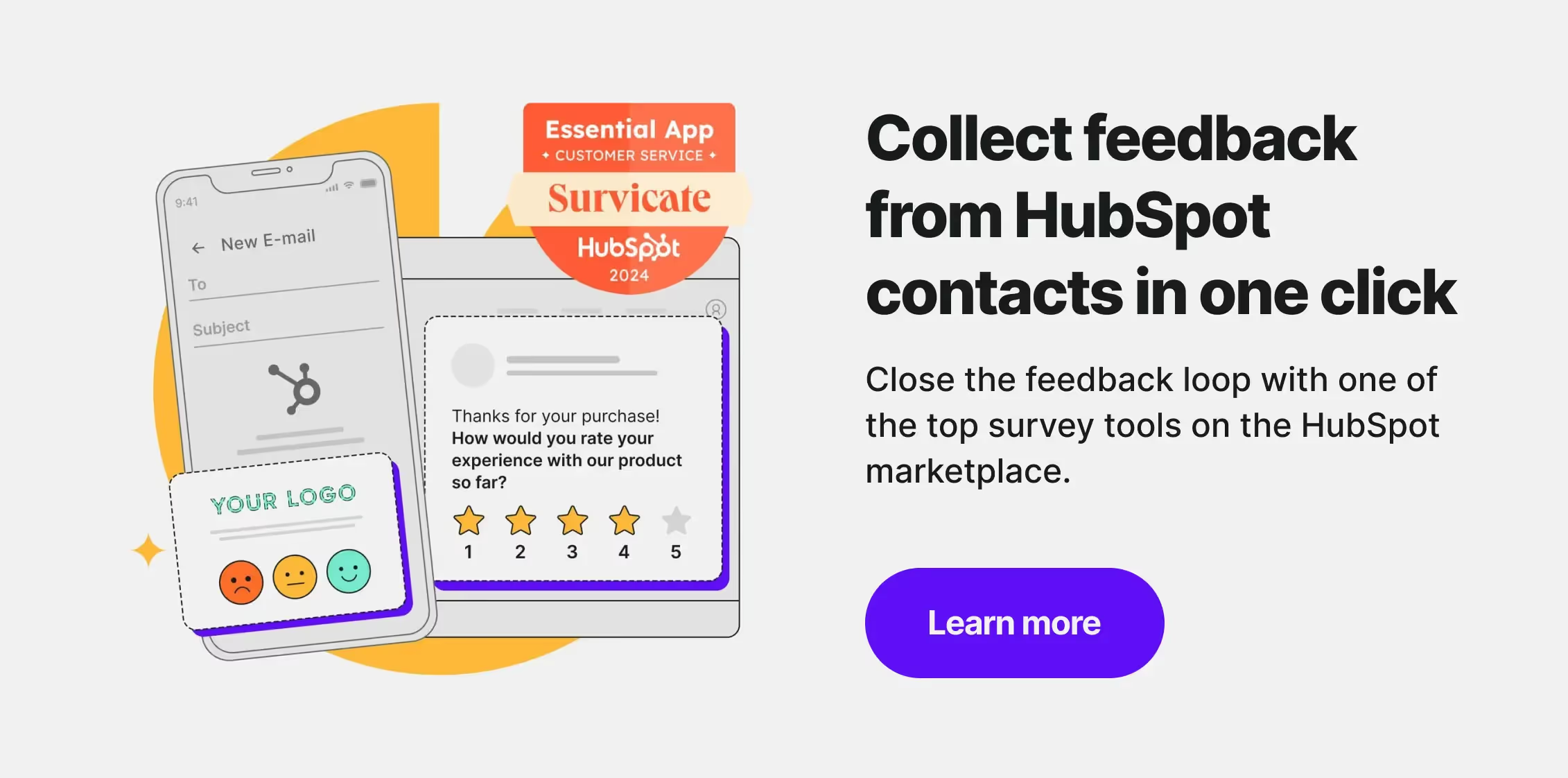
2. Use Insights Hub to turn open-text feedback into actionable insights
While the basic customer experience metrics are solid numbers, there’s a ton of qualitative feedback that comes from customer support interactions, online reviews, emails, and surveys.
As tedious as it used to be parse through multiple sources and endless spreadsheets of data, those painful times are over now. AI-powered features handle it once and for all.
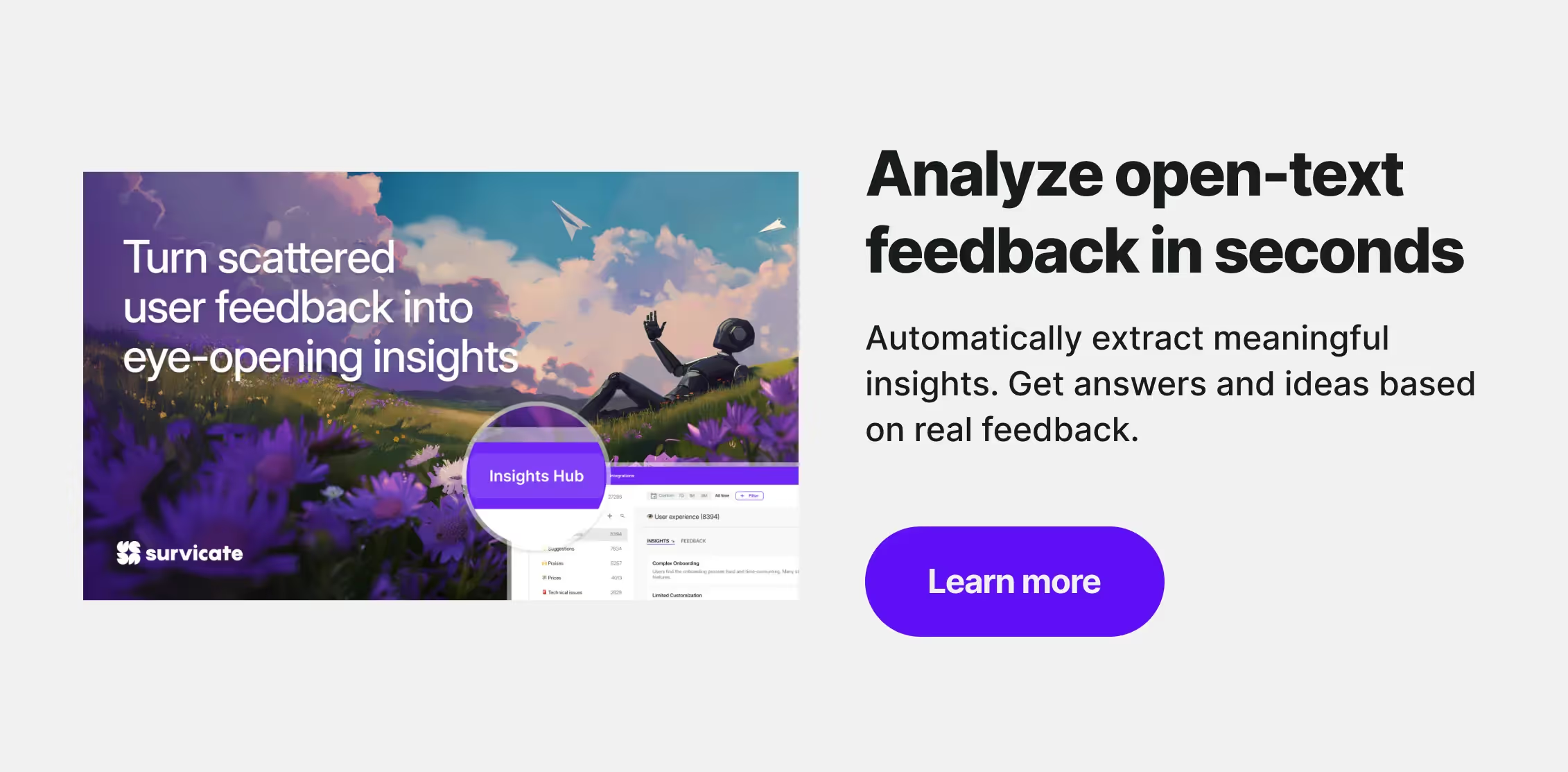
Insights Hub is an excellent example of a customer feedback management tool that aggregates all your text feedback, and then categorizes and analyzes it to come up with actionable insights in a snap.
3. Build a feedback culture and customer obsession (Slack integration)
NPS is Preply’s company-wide North Star metric., As an organization, they live and breathe customer centricity.
We have a set of company values, and customer obsession is one of the key values, and it's not like only on paper. We try to embed it in all the processes that we have. We try to cultivate customer obsession and force all the decisions so they would be not only data-driven but also customer-driven. We try to ensure that all our solutions are based on customer problems.
Kateryna Martynova, Head of Research at Preply
To make customer feedback more accessible to different teams, they use the Survicate-Slack integration.
The effect? It sparked cross-team discussions under survey responses, making them topics of conversation as they were coming in. In other words, living the best customer experience era at Preply.
💡 Read the whole Preply customer story
4. Gather direct customer feedback to close the feedback loop like Hitta
Collecting customer feedback is an efficient way to have see your product from your customers’ perspective. But it’s not the overall aim. The goal is to use these insights to improve your product and reach business goals, such as increasing LTV, customer retention, and loyalty. In short, to close the feedback loop.
Take Hitta’s example. They decided to measure NPS, and it soon showed some important gaps in the customer journey. After analyzing results, they decided to make some changes in the onboarding process.
We chose the NPS because it’s more of a benchmark way of comparing with other types of businesses within the same area.
Alice Samuelsson, Product Manager at Hitta
Importantly, the NPS has become a metric that influences workflows company-wide—from product to customer-facing teams. With this holistic approach, they’ve already improved their Net Promoter Score by 35%.
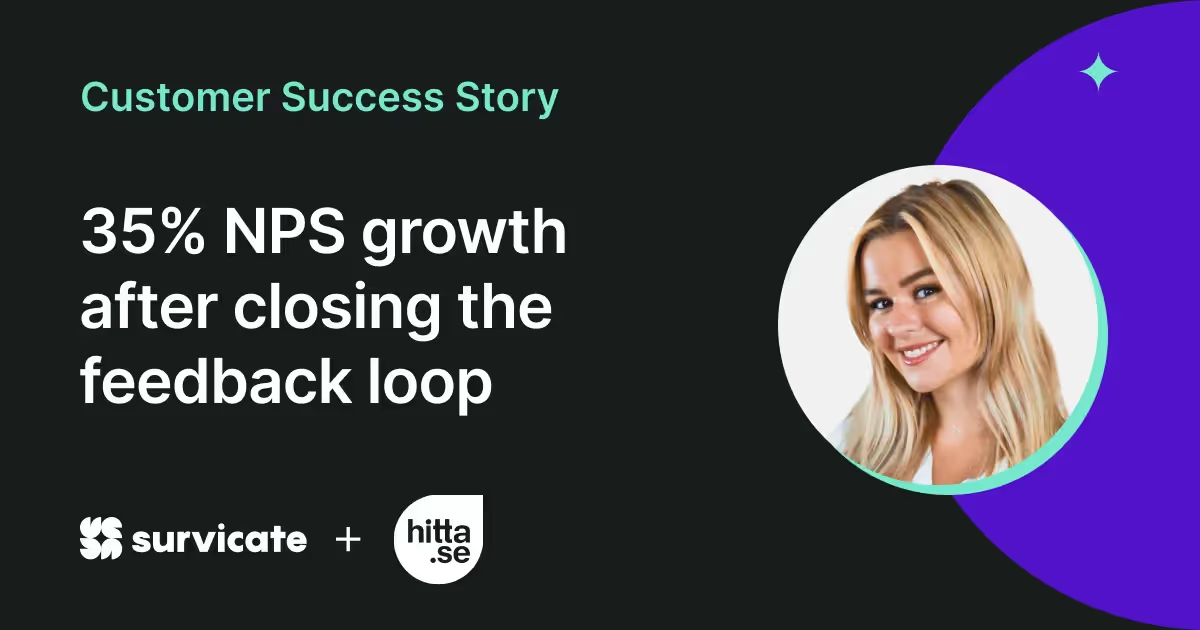
💡 Read the whole Hitta.se customer story
Best customer experience tools
Survicate
Survicate is a customer feedback management platform that lets you create custom surveys to collect user feedback across all channels—email, web, in-product, and mobile apps.
Our AI-powered Insights Hub takes those survey responses (plus feedback from all other sources) and turns them into clear, actionable insights.
What’s the best about it?
⭐️ Effortless insights: With AI-powered features such as Insights Hub and Research Assistant, your open-text feedback is categorized and turned into ready-to-go, actionable insights.
⭐️ Real-time feedback: You can instantly collect and analyze customer feedback across various touchpoints (email, website, in-product, mobile app)
⭐️ Seamless integrations: Survicate easily integrates with popular tools so that you can automate your workflows more easily and quickly.
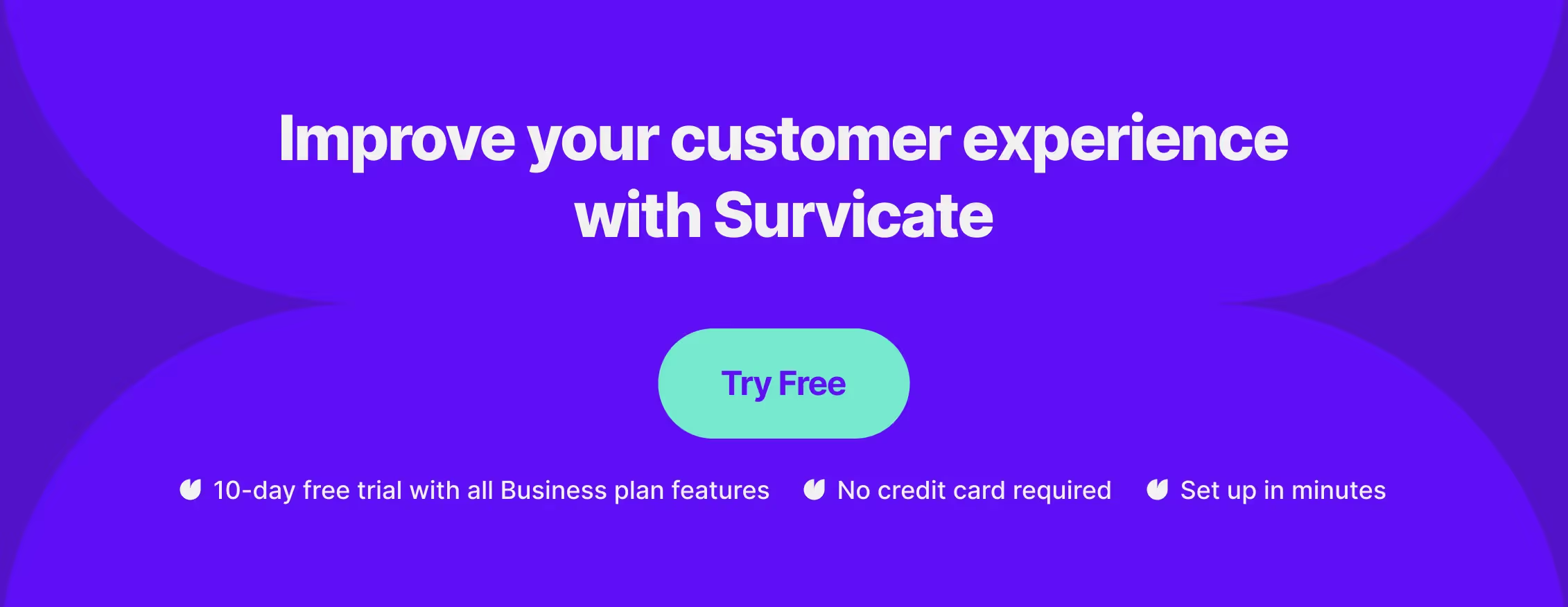
Survicate
Survicate is a customer feedback management platform that lets you create custom surveys to collect user feedback across all channels—email, web, in-product, and mobile apps.
Our AI-powered Insights Hub takes those survey responses (plus feedback from all other sources) and turns them into clear, actionable insights.
What’s the best about it?
Effortless insights: With AI-powered features such as Insights Hub and Research Assistant, your open-text feedback is categorized and turned into ready-to-go, actionable insights.
Real-time feedback: You can instantly collect and analyze customer feedback across various touchpoints (email, website, in-product, mobile app)
Seamless integrations: Survicate easily integrates with popular tools so that you can automate your workflows more easily and quickly.
HubSpot - Service Hub
HubSpot's Service Hub is a comprehensive customer service platform designed to help businesses engage with customers, resolve issues, and build long-term relationships through a unified support system.
What’s the best about it?
⭐️ Unified customer service: You can manage all customer interactions in one place, providing a seamless support experience.
⭐️ Automation and ticketing: With automated ticketing and support workflows, you ensure timely responses to customer inquiries.
⭐️ Knowledge base integration: HubSpot allows you to create and manage a knowledge base to empower customers with self-service options and reduce support load.
💡Tip: Explore our native Survicate-HubSpot integration and create feedback-based workflows.
Zendesk
Zendesk is a widely-used customer service software that provides tools for managing customer support tickets, live chats, and knowledge bases, helping businesses deliver efficient and personalized support.
What’s the best about it?
⭐️ Omnichannel support: Offer customer support across multiple channels, including email, chat, and social media.
⭐️ Advanced analytics: The access to in-depth reporting and analytics helps track performance and optimize support operations.
⭐️ Customizable workflows: Tailor support workflows and automate repetitive tasks to improve efficiency.
💡Tip: Check our native Survicate-Zendesk integration to send surveys and track satisfaction with new or existing tickets.
Intercom
Intercom is a customer messaging platform that enables businesses to communicate with customers through live chat, bots, and in-app messaging, enhancing customer engagement and support.
What’s the best about it?
⭐️ Personalized messaging: You can send targeted messages based on user behavior and segment customers for more relevant communication.
⭐️ Automation with bots: AI-driven bots automate routine inquiries and provide instant responses.
⭐️ In-app support: You can provide real-time support directly within your app or website, improving user experience and satisfaction.
💡Tip: With our native Survicate-Intercom integration you can save responses as Intercom tags and attributes. What’s more, you can use customer feedback from Intercom with Survicate’s Insights Hub
Salesforce
Salesforce is a leading customer relationship management (CRM) platform that helps businesses manage customer interactions, track sales, and deliver personalized customer experiences across all touchpoints.
What’s the best about it?
⭐️ Comprehensive CRM: Centralize all customer data, providing a 360-degree view of customer interactions and history.
⭐️ Customizable solutions: Tailor the platform to meet specific business needs with a wide range of customizable features and integrations.
⭐️ Scalable: Suitable for businesses of all sizes, from small startups to large enterprises, with the ability to scale as you grow.
💡Tip: Survicate-Salesforce integration allows you to embed Survicate surveys directly into Salesforce emails. You can also trigger Salesforce workflows based on survey responses.








.webp)
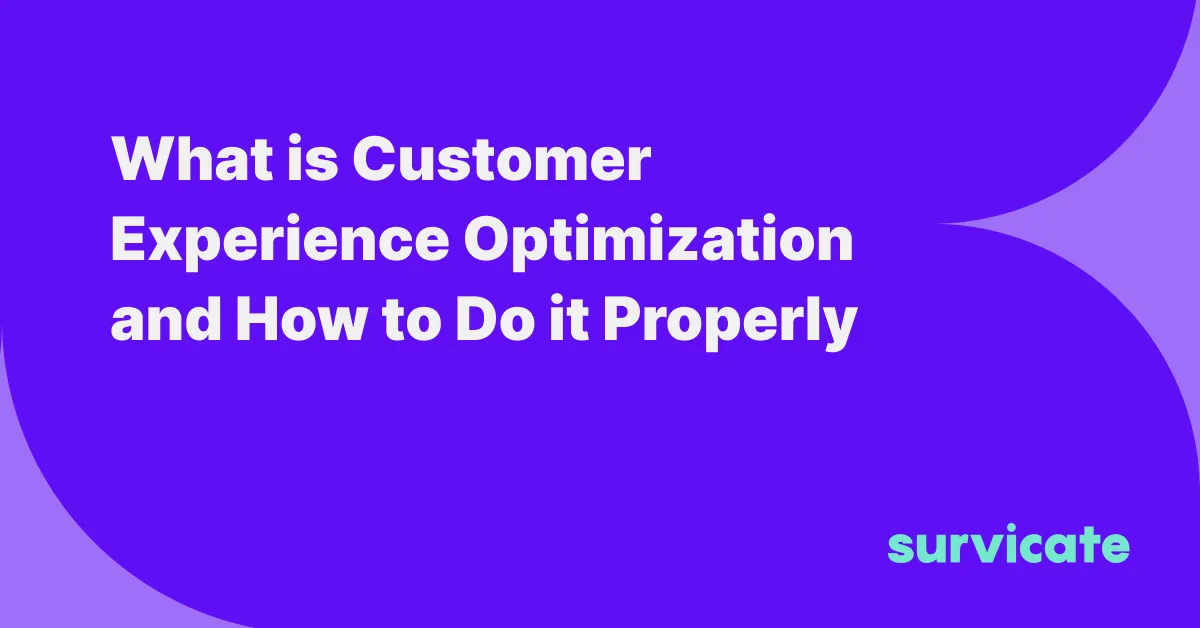

.webp)
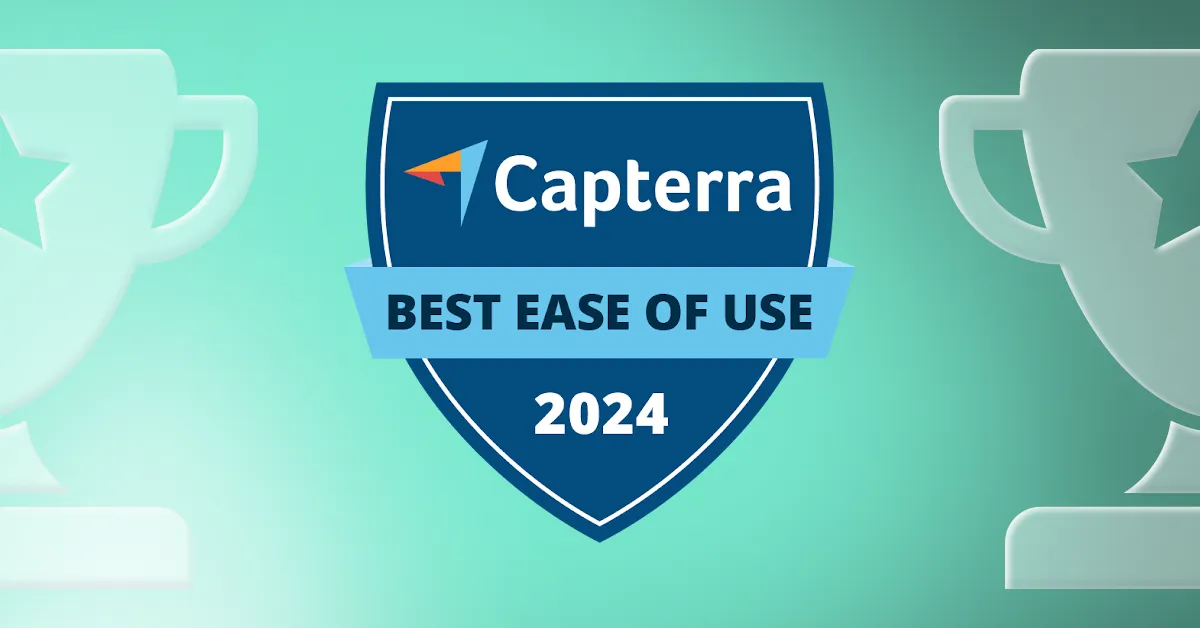
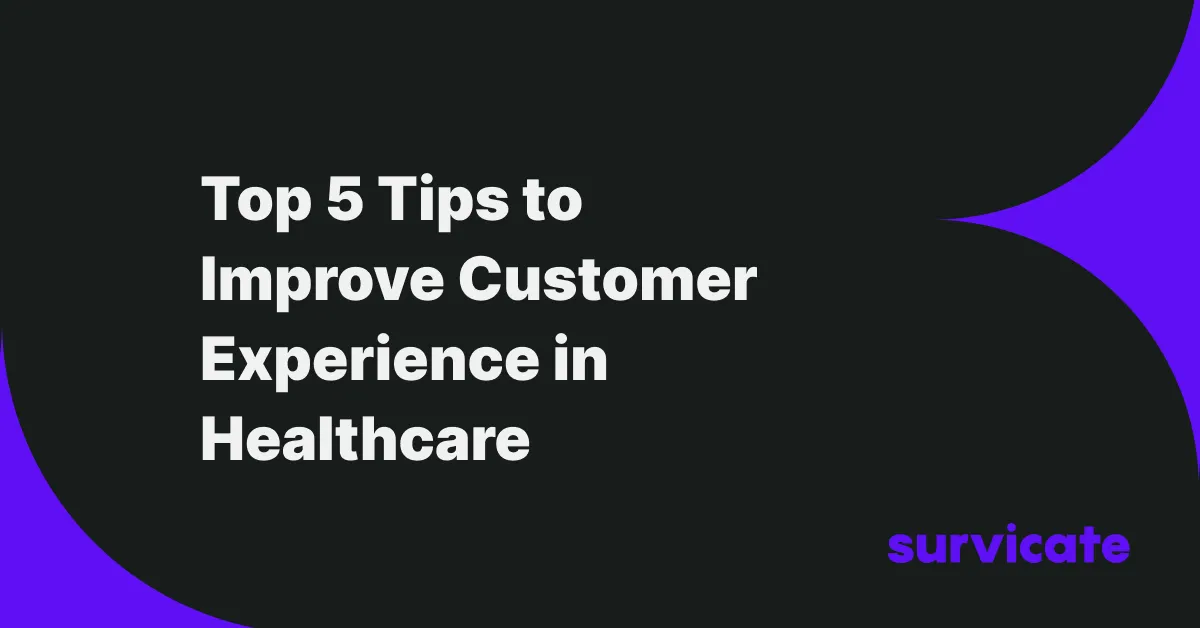
.svg)

.svg)



